Method and system for improved analog signal detection
a technology of analog signal detection and detection system, applied in the field of methods and systems for improving analog signal detection, can solve the problems of affecting the detection of such signals in environments where noise or speech is present, and affecting the detection of valid dtmf signaling tones, etc., to achieve the effect of increasing the accuracy of determining
- Summary
- Abstract
- Description
- Claims
- Application Information
AI Technical Summary
Benefits of technology
Problems solved by technology
Method used
Image
Examples
example 2
Referring now to FIGS. 14A, 14B, and 14C, which are a screen captures of a simulation of an embodiment of the present invention, shown are frame and sub-frame interval energies. Example 2 illustrates the usefulness of the energy-increase counts when the detector is running in the presence of speech only. Here, the simulated speech level is -12 dBm and FIG. 14A shows that the speech is at a moderately high level. FIGS. 14B and 14C are the energy outputs from the 2130 Hz and 2750 Hz detectors respectively.
In FIG. 14C, it can be seen that sub-frame (-1) of the 2750 detector indicates that this could be the start sub-frame of a possible CAS tone: the final sub-frame energy is high and it has 3 linearly increasing energy values at 96, 125 and 160 samples. However, the absence of energy in the 2130 detector disallows this sub-frame since both tones must be present simultaneously and meet the power differential of + / -6 dBs between the tones. However, if one examines the next 4 sub-frames, ...
example 3
Examination of FIGS. 15A and 15B, which are a screen captures of a simulation of an embodiment of the present invention, shown are frame and sub-frame interval energies. These figures illustrate the usefulness of these energy-increase counts when the detector is detecting a CAS tone in the presence of moderately high speech levels. Again, the speech signal level is -12 dBm, as in FIG. 14A. In FIG. 15A, it can be seen that the final energy detection for the 2130 Hz tone in frame 3 is negligible and, in consequence, the power differential of + / -6 dBs between the tones is not met. Also, the power differential in frame 1 is also outside the required value. Since the energy outputs from the detector should be the same as those in FIG. 13, where the input signal to the detector was a CAS tone at -32 dBm with a duration of 80 ms, it can be seen that the presence of speech has disrupted the detection process. The actual figures for the detector are shown in Table 5 below:
Thus, if the final ...
PUM
 Login to View More
Login to View More Abstract
Description
Claims
Application Information
 Login to View More
Login to View More - R&D
- Intellectual Property
- Life Sciences
- Materials
- Tech Scout
- Unparalleled Data Quality
- Higher Quality Content
- 60% Fewer Hallucinations
Browse by: Latest US Patents, China's latest patents, Technical Efficacy Thesaurus, Application Domain, Technology Topic, Popular Technical Reports.
© 2025 PatSnap. All rights reserved.Legal|Privacy policy|Modern Slavery Act Transparency Statement|Sitemap|About US| Contact US: help@patsnap.com



